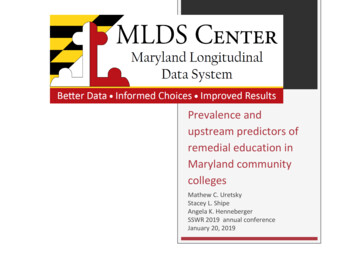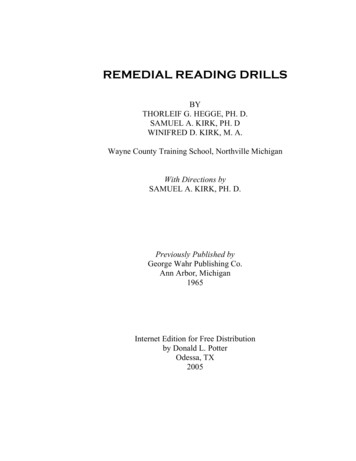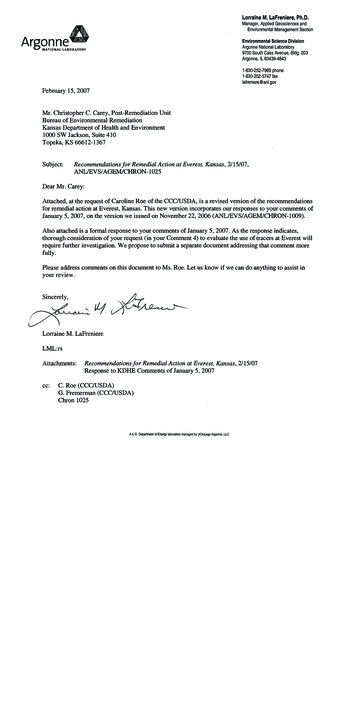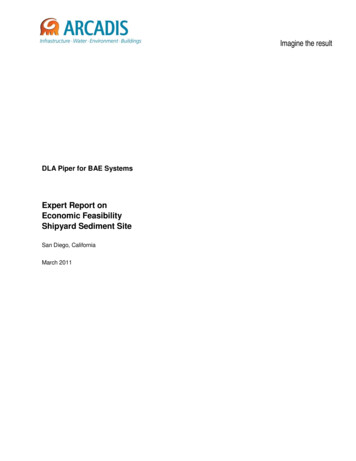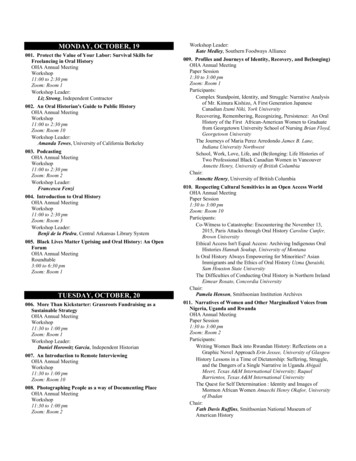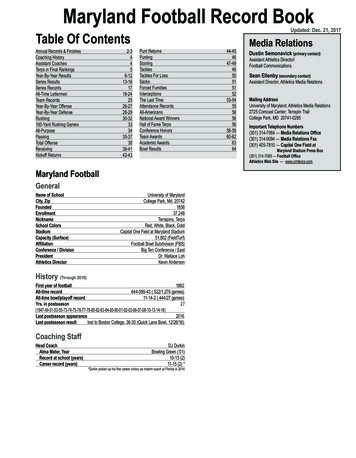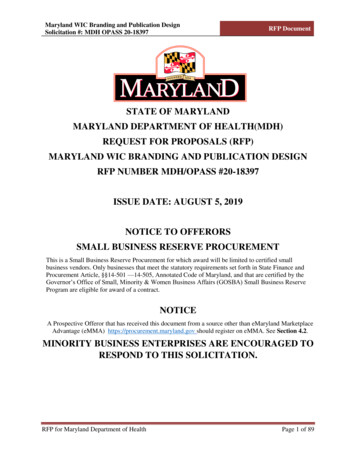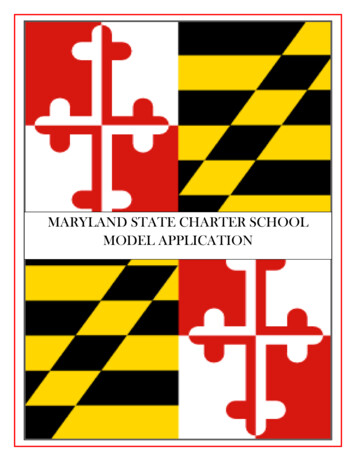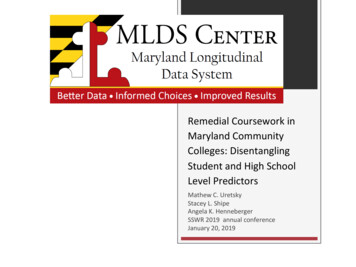
Transcription
Remedial Coursework inMaryland CommunityColleges: DisentanglingStudent and High SchoolLevel PredictorsMathew C. UretskyStacey L. ShipeAngela K. HennebergerSSWR 2019 annual conferenceJanuary 20, 2019
Introduction A college-ready student should enter college withthe expectation of passing college coursework.Underprepared students need to take remedialcoursework to prepare for college levelNationally, about 30-40% of students enteringcollege need to take remedial coursework (NCES,2014; Rose, 2012).May indicate a mismatch in high schoolacademic preparation and college academicexpectations.
Introduction Continued Minority students and low SES students are morelikely to need remedial coursework (Attewell et al.,2006).High school academics also related to need forremedial coursework (Chen, 2016; Radford et al., 2012).Needing remedial coursework is associated withnegative outcomes (Attewell et al., 2006; Clotfelter et al.,2015).Highlights the importance of early identificationand intervention.
The Current Study Focuses on Maryland Community College students Represent the majority of students who need remedialcoursework (Chen, 2016; Henneberger et al., 2016)Have a common cut point to determine need (Halbach,2015) Expands upon the prior study to include high schoollevel predictors of remedial coursework Disentangling the role of student- and high schoollevel factors will help policy makers to determinewhether student-oriented or school-orientedprevention may be most useful.
Method: Data Linked data sources postsecondary, collegeenrollment, and assessment data5 years of administrative records from MLDS 18,800 students attending228 high schools across24 local school systems in MarylandInclusion criteria Maryland public high school graduate AY 2013-2014Enrolled in Maryland Community College AY 20142015
Sample Selection Criteria
Method: Measures Dependent variable - Need for remedial courseworkin (1) math & (2) EnglishIndependent Variables Individual student characteristics. demographic characteristicsattendance and academic performance; andplacement characteristicsHigh School-Level characteristics % FARMS% English Learner (EL)% fifth year graduateAverage weeks attended
Method: Analyses Multilevel logit models Two-level model (Student nested within school)Dummy variables for 24 Maryland jurisdictionsRandom effects to model the interceptsFixed effects for the independent variablesAll continuous covariates were grand-mean centeredlog-likelihood difference test
Rates of Need for RemedialCoursework by Subject Area
Results for the Multilevel Model Student Characteristics (Math)
Results for the Multilevel Model School Characteristics (Math)
Discussion High levels of need for remedial coursework inMaryland community colleges Both individual-level and high school-levelcharacteristics predict need for remedial coursework Highest rate for mathIndicates the potential for multi-layered interventionat both the student and school levelsResults were consistent for math and English withslight differences
Discussion - Student Level Student-level academic performance in high schoolhad a larger influence on the odds that a studentwould need remedial education than sociodemographic factors. EL student placement and fifth-year graduationfunctioned as protective factors The extra support provided to these students mayhelp to alleviate the need for remedial courseworkupon entering a Maryland community college.
Discussion - School level FARMs Schools may be under-resourced in terms of preparingstudents for college-level courseworkPercentage of fifth-year graduates Additional supports may be provided in these schoolsSchools with more experience with fifth yeargraduates may be better at preparing all students forcollege level math
Limitations Not able to control for confounders not included inthe MLDS, found to be important in other studies Behavioral variablesParental educationSchool climateTeacher professional development on collegereadinessDichotomous yes/no outcomes
Future Research Fifth-year of high school vs. remedial in collegeEarly identification - trajectoriesHigh school course taking patternsSubject overlapMeasurement issues PsychometricsRegression discontinuity
For More InformationHTTPS://MLDSCENTER.MARYLAND.GOV/
AcknowledgementsWe are grateful for the data, technical, and researchsupport provided by the MLDS Center and its agencypartners. The views and opinions expressed are those ofthe authors and do not necessarily represent the views ofthe MLDS Center or its agency partners.Thanks to the MLDSC Research Team and Research andPolicy Advisory Board, participants at the MLDS ResearchSeries and MD Connections Summit, and MSDE andMHEC staff for helpful input.
Questions and ContactMathew C. Uretsky, Ph.D., MSW, MPHAssistant ProfessorPortland State Universitymuretsky@pdx.eduStacey L. Shipe, PhD, MSc, MSWAssistant ProfessorBinghamton Universitysshipe@binghamton.eduAngela K. Henneberger, Ph.D.Director of ResearchMaryland Longitudinal Data System Centerangela.henneberger@maryland.gov
Discussion High levels of need for remedial coursework in Maryland community colleges Highest rate for math Both individual-level and high school-level characteristics predict need for remedial coursework Indicates the potential for multi-layered intervention at both the student and school levels Results were consistent for math and English with
